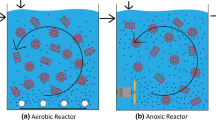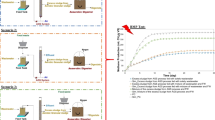Abstract
Waste liquid streams from distillery were a hurdle in conventional wastewater treatment due to extreme high chemical oxygen demand (COD) and fluctuating feed conditions. A recently commissioned full-scale external circulation sludge bed (ECSB) was applied at a malt whiskey distillery in northeast Taiwan. Start-up of the new ECSB system, which has a total volume of 490 m3 with diameter of 6.55 m (ø) and height of 15.9 m (H), was performed by gradual increasing influent flow rates from zero to the design value of 300 m3 day−1 in the first 90 days. In the subsequent 204 days, both influent flow rates (0–389 m3 day−1) and COD concentrations (2.8–18.1 kg L−1) were highly fluctuated due to diverse batches from the distillery. However, effective bioremediation (COD removal 95.1 ± 2.4%) and biogas production (1195 ± 724 L day−1) were achieved in this system. Intensively, the Imhoff tests were carried out and shown the settled solids concentration by 0.5 ± 0.4 mL L−1, while size distributions of granular sludge were analyzed and observed by SEM-EDS. In addition, developments of the anaerobic systems (including lab, pilot, and full scale from the simplest reactor to the latest ECSB) applied in whiskey wastewater treatment were reviewed with their operational parameters for comparing performances of various anaerobic systems. In general, real-time monitoring and feasible operation strategies were critical to successfully run the system by producing clean energy simultaneously. It provides more economically attractive and sustainable-to-adopt ECSB not only an end-of-pipe process but also a bioresource technology.






Similar content being viewed by others
References
Abbasi T, Tauseef SM, Abbasi SA (2012) Anaerobic digestion for global warming control and energy generation—an overview. Renew Sust Energ Rev 16:3228–3242
Acharya BK, Pathak H, Mohana S, Shouche Y, Singh V, Madamwar D (2011) Kinetic modelling and microbial community assessment of anaerobic biphasic fixed film bioreactor treating distillery spent wash. Water Res 45:4248–4259
Agarwal R, Lata S, Gupta M, Singh P (2010) Removal of melanoidin present in distillery effluent as a major colorant: a review. J Environ Biol 31:521–528
Akunna JC, Clark M (2000) Performance of a granular-bed anaerobic baffled reactor (GRABBR) treating whisky distillery wastewater. Bioresour Technol 74:257–261
Anonymous (2016) Bio-energy plants transform whisky distillery sector. Filtration+Separation. Nov–Dec. 2016.
Arimi MM, Zhang Y, Götz G, Kiriamiti K, Geißen S-U (2014) Antimicrobial colorants in molasses distillery wastewater and their removal technologies. Int Biodeterior Biodegrad 87:34–43
Barrena R, Traub JE, Gil CR, Goodwin JAS, Harper AJ, Willoughby NA, Sánchez A, Aspray TJ (2018) Batch anaerobic digestion of deproteinated malt whisky pot ale using different source inocula. Waste Manag 71:675–682
Bathgate GN (2016) A review of malting and malt processing for whisky distillation. J Inst Brew 122:197–211
Bilad MR, Declerck P, Piasecka A, Vanysacker L, Yan X, Vankelecom IFJ (2011) Treatment of molasses wastewater in a membrane bioreactor: influence of membrane pore size. Sep Purif Technol 78:105–112
Chowdhary P, Raj A, Bharagava RN (2018) Environmental pollution and health hazards from distillery wastewater and treatment approaches to combat the environmental threats: a review. Chemosphere 194:229–246
Connaughton S, Collins G, O’Flaherty V (2006) Psychrophilic and mesophilic anaerobic digestion of brewery effluent: a comparative study. Water Res 40:2503–2510
Connelly S, Shin SG, Dillon RJ, Ijaz UZ, Quince C, Sloan WT, Collins G (2017) Bioreactor scalability: laboratory-scale bioreactor design influences performance, ecology, and community physiology in Expanded Granular Sludge Bed bioreactors. Front Microbiol 8:664 15 pages
Enitan AM, Adeyemo J, Swalaha FM, Bux F (2015) Anaerobic digestion model to enhance treatment of brewery wastewater for biogas production using UASB reactor. Environ Model Assess 20:673–685
Fang HHP (ed) (2010) Environmental anaerobic technology: applications and new developments. Imperial College Press, London
Fatih Demirbas M, Balat M (2009) Progress and recent trends in biogas processing. Int J Green Energy 6:117–142
Fuess LT, Garcia ML (2014) Implications of stillage land disposal: a critical review on the impacts of fertigation. J Environ Manag 145:210–229
Fuess LT, Garcia ML (2015) Bioenergy from stillage anaerobic digestion to enhance the energy balance ratio of ethanol production. J Environ Manag 162:102–114
Gao M, She Z, Jin C (2007) Performance evaluation of a mesophilic (37oC) upflow anaerobic sludge blanket reactor in treating distiller’s grains wastewater. J Hazar. Mater 141:808–813
Ghorbanian M, Lupitskyy RM, Satyavolu JV, Berson RE (2014a) Impact of supplemental hydrogen on biogas enhancement and substrate removal efficiency in a two-stage expanded granular sludge bed reactor. Environ Eng Sci 31:253–260
Ghorbanian M, Lupitskyy RM, Satyavolu JV, Berson RE (2014b) Impact of hydraulic retention time at constant organic loading rate in a two-stage expanded granular sludge bed reactor. Environ Eng Sci 31:317–323
Goodwin JAS, Stuart JB (1994) Anaerobic digestion of malt whisky distillery pot ale using upflow anaerobic sludge blanket reactors. Bioresour Technol 49:75–81
Goodwin JAS, Finlayson JM, Low EW (2001) A further study of the anaerobic biotreatment of malt whisky distillery pot ale using an UASB system. Bioresour Technol 78:155–160
Graham J, Peter B, Walker G, Wardlaw A, Campbell E (2012) Characterisation of the pot ale profile from a malt whisky distillery. In: Walker GM, Goodall I, Fotheringham R, Murray D (eds) Distilled spirits: science and sustainability, vol 43. Nottingham University Press, Nottingham, pp 1–7
Guo K, Shang Y, Gao B, Xu X, Lu S, Qi Q (2018) Study on the treatment of soybean protein wastewater by a pilot-scale IC-A/O coupling reactor. Chem Eng J 343:189–197
Harada H, Uemura S, Chen A, Jayadevan J (1996) Anaerobic treatment of a recalcitrant distillery wastewater by a thermophilic UASB reactor. Bioresour Technol 55:215–221
Hosseini SE, Wahid MA (2014) Development of biogas combustion in combined heat and power generation. Renew Sust Energ Rev 40:868–875
Hutnan M, Hornak M, Bodik I, Hlavacka V (2003) Anaerobic treatment of wheat stillage. Chem Biochem Eng Q 17:233–241
Khanal SK, Giri B, Nitayavardhana S, Gadhamshetty V (2016) Anaerobic bioreactors/digesters: design and development In: Lee D-J, Hallenbeck P, Ngo H, Jegatheesan V, Pandey A (eds) Current developments in biotechnology and bioengineering: biological treatment of industrial effluents, vol 10. 1st edn. Elsevier, pp 261–279. https://doi.org/10.1016/B978-0-444-63665-2.00010-2
Kharayat Y (2012) Distillery wastewater: bioremediation approaches. J Integr Environ Sci 9:69–91
Krishnamoorthy S, Premalatha M, Vijayasekaran M (2017) Characterization of distillery wastewater – an approach to retrofit existing effluent treatment plant operation with phycoremediation. J Clean Prod 148:735–750
Kumar GS, Gupta SK, Singh G (2007) Biodegradation of distillery spent wash in anaerobic hybrid reactor. Water Res 41:721–730
Laubscher ACJ, Wentzel MC, Le Roux JMW, Ekama GA (2001) Treatment of grain distillation wastewater in an upflow anaerobic sludge bed (UASB) system. Water SA 27:433–444
Lim SJ, Kim T-H (2014) Applicability and trends of anaerobic granular sludge treatment processes. Biomass Bioenergy 60:189–202
Mallick P, Akunna JC, Walker GM (2010) Anaerobic digestion of distillery spent wash: influence of enzymatic pre-treatment of intact yeast cells. Bioresour Technol 101:1681–1685
Mao C, Feng Y, Wang X, Ren G (2015) Review on research achievements of biogas from anaerobic digestion. Renew Sust Energ Rev 45:540–555
Melamane XL, Strong PJ, Burgess JE (2007) Treatment of wine distillery wastewater: a review with emphasis on anaerobic membrane reactors. S Afr J Enol Vitic 28:25–36
Metcalf & Eddy Inc., Tchobanoglous G, Stensel HD, Tsuchihashi R, Burton F (2014) Anaerobic suspended and attached growth biological treatment processes. In: Wastewater engineering: treatment and resource recovery, vol 10. 5th edn. McGraw-Hill Education, New York, pp 1060–1103
Meyer T, Edwards EA (2014) Anaerobic digestion of pulp and paper mill wastewater and sludge. Water Res 65:321–349
Mohana S, Acharya BK, Madamwar D (2009) Distillery spent wash: Treatment technologies and potential applications. J Hazard Mater 163:12–25
Onodera T, Choeisai P, Khodphuvieng J, Prammanee P, Yoochatchaval W, Kaewpradit W, Kubota K (2013) Development of appropriate technology for treatment of molasses-based wastewater. J Environ Sci Health A 48:1114–1121
Pant D, Adholeya A (2007) Biological approaches for treatment of distillery wastewater: A review. Bioresour Technol 98:2321–2334
Petta L, De Gisi S, Casella P, Farina R, Notarnicola M (2017) Evaluation of the treatability of a winery distillery (vinasse) wastewater by UASB, anoxic- aerobic UF-MBR and chemical precipitation/adsorption. J Environ Manag 201:177–189
Prajapati AK, Chaudhari PK (2015) Physicochemical treatment of distillery wastewater―a review. Chem Eng Commun 202:1098–1117
Russell I, Stewart G (eds) (2014) Whisky: technology, production and marketing, 2nd edn. Elsevier Science Publishing Co Inc, United States
Saner AB, Mungray AK, Mistry NJ (2016) Treatment of distillery wastewater in an upflow anaerobic sludge blanket (UASB) reactor. Desalin Water Treat 57:4328–4344
Schmidt T, Pröter J, Scholwin F, Nelles M (2013) Anaerobic digestion of grain stillage at high organic loading rates in three different reactor systems. Biomass Bioenergy 55:285–290
Stout D (2015) You won’t believe where the world’s best whiskey comes from. TIME. http://time.com/3753768/world-best-whisky-taiwan-kavalan-world-whiskies-awards/ Accessed 30 May 2018.
Sun H, Wu S, Dong R (2016) Monitoring volatile fatty acids and carbonate alkalinity in anaerobic digestion: titration methodologies. Chem Eng Technol 39:599–610
Tauseef SM, Abbasi T, Abbasi SA (2013) Energy recovery from wastewaters with high-rate anaerobic digesters. Renew Sust Energ Rev 19:704–741
Tiwari MK, Guha S, Harendranath CS, Tripathi S (2006) Influence of extrinsic factors on Granulation in UASB reactor. Appl Microbiol Biotechnol 71:145–154
Tokuda M, Fujiwara Y, Kida K (1999) Pilot plant test removal of organic matter, N and P from whisky pot al. Process Biochem 35:265–267
Uzal N, Gokcay CF, Demirer GN (2003) Sequential (anaerobic/aerobic) biological treatment of malt whisky wastewater. Process Biochem 39:279–286
Uzukwu CC, Barraclough MJ, Dionisi D (2017) Experimental investigation of a new process for treatment and valorisation of pot ale wastewaters. Water Sci Technol 75:1194–1203
van Lier JB (2008) High-rate anaerobic wastewater treatment: diversifying from end-of-the-pipe treatment to resource-oriented conversion techniques. Water Sci Technol 57:1137–1148
van Lier JB, van der Zee FP, Frijters CTMJ, Ersahin ME (2016) Development of anaerobic high-rate reactors, focusing on sludge bed technology. Adv Biochem Eng Biotechnol 14:681–702
Weber B, Stadlbauer EA (2017) Sustainable paths for managing solid and liquid waste from distilleries and breweries. J Clean Prod 149:38–48
Wilkie AC, Riedesel KJ, Owens JM (2000) Stillage characterization and anaerobic treatment of ethanol stillage from conventional and cellulosic feedstocks. Biomass Bioenergy 19:63–102
Wolmarans B, de Villiers GH (2002) Start-up of a UASB treatment plant on distillery wastewater. Water SA 28:63–68.
Yamada M, Harada H, Yamauchi M, Yamaguchi T, Ohashi A (2013) Reduction of alkali supplement in a pilot-scale thermophilic multi-staged UASB reactor treating alcohol distillery wastewater. Int J Environ Res 7:823–830
Zero Waste Scotland, Sector study on beer, whisky and fish (2015) 87 pages, http://www.zerowastescotland.org.uk/BeerWhiskyFish. Accessed 30 May 2018.
Acknowledgments
Efforts of employees in the Kavalan distillery during the system operation and intensive monitoring as well as supports from HydroThane during the constructing the ECSB system were both highly appreciated. Additional water and sludge analysis from Prof. Wen-Hsing Chen in National Ilan University was acknowledged.
Author information
Authors and Affiliations
Corresponding author
Additional information
Responsible editor: Philippe Garrigues
Publisher’s Note
Springer Nature remains neutral with regard to jurisdictional claims in published maps and institutional affiliations.
Rights and permissions
About this article
Cite this article
Lin, YC., Ni, CH., Wu, CY. et al. A full-scale study of external circulation sludge bed (ECSB) system for anaerobic wastewater treatment in a whiskey distillery. Environ Sci Pollut Res 26, 34261–34276 (2019). https://doi.org/10.1007/s11356-018-4018-3
Received:
Accepted:
Published:
Issue Date:
DOI: https://doi.org/10.1007/s11356-018-4018-3




